Paisley
| Paisley | |
| Scottish Gaelic: Pàislig | |
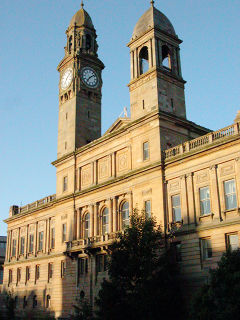 Paisley Town Hall |
|
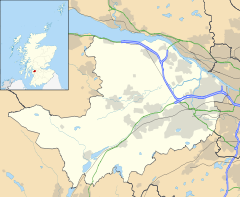 Paisley
|
|
| Population | 74,000 |
|---|---|
| OS grid reference | |
| - Edinburgh | 49 mi (79 km) E |
| - London | 347 mi (558 km) SSE |
| Council area | Renfrewshire |
| Lieutenancy area | Renfrewshire |
| Country | Scotland |
| Sovereign state | United Kingdom |
| Post town | PAISLEY |
| Postcode district | PA1 - PA3 |
| Dialling code | 0141 & 01505 |
| Police | Strathclyde |
| Fire | Strathclyde |
| Ambulance | Scottish |
| EU Parliament | Scotland |
| UK Parliament | Paisley and Renfrewshire North |
| Paisley and Renfrewshire South | |
| Scottish Parliament | Paisley North |
| Paisley South | |
| West of Scotland | |
| List of places: UK • Scotland • | |
Paisley (Scottish Gaelic: Pàislig) is a town and a former burgh in the west-Central Lowlands of Scotland. It is situated on the northern edge of the Gleniffer Braes, straddling the banks of the River Cart. Paisley is the administrative capital of the Renfrewshire council area, and forms a continuous urban area with Greater Glasgow, Glasgow City Centre being 6.9 miles (11.1 km) to the east.
Contents |
History
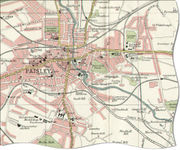
Formerly known as Paislay[1] the burgh's name is of uncertain origin; some sources suggest a derivation either from the Brythonic word, pasgill, 'pasture', or more likely, passeleg - 'basilica', (i.e. major church), itself derived from the Greek βασιλική basilika. However, some Scottish place-name books {which?} suggest "Pæssa's wood/clearing", from the Old English personal name Pæssa and leāh - "clearing, wood". Pasilege (1182) and Paslie (1214) are recorded previous spellings of the name.
Paisley has monastic origins. A chapel is said to have been established by the 6th/7th century Irish monk, Saint Mirin at a site near a waterfall on the White Cart Water known as the Hammils. Though Paisley lacks contemporary documentation it may have been, along with Glasgow and Govan, a major religious centre of the Kingdom of Strathclyde. A priory was established in 1163 from the Cluniac priory at Wenlock in Shropshire, England at the behest of Walter Fitzalan (d. 1177) High Steward of Scotland. In 1245 this was raised to the status of an Abbey. The restored Abbey and adjacent 'Place' (palace), constructed out of part of the medieval claustral buildings, survive as a Church of Scotland parish church. One of Scotland's major religious houses, Paisley Abbey was much favoured by the Bruce and Stewart royal families. It is generally accepted that William Wallace the great hero of Scottish independence who inspired the film Braveheart was educated here. King Robert III (1390–1406) was buried in the Abbey. His tomb has not survived, but that of Princess Marjorie Bruce (1296–1316), ancestor of the Stewarts, is one of Scotland's few royal monuments to survive the Reformation.
Paisley coalesced under James II's wish that the lands should become a single regality and, as a result, markets, trading and commerce began to flourish. In 1488 the town's status was raised by James IV to Burgh of barony.
Many trades sprang up and the first school was established in 1577 by the Town Council. By the mid-nineteenth century weaving had become the town's principal industry. Paisley is still very well-known for the Paisley Shawl and its reproduction Paisley Pattern, which became fashionable around this time.[2]
Through its weaving fraternity, Paisley gained note as being a literate and somewhat radical town. By this time there was a real mixture of religious opinions and healthy drink-fueled debate raged at night amongst the weavers, poets, merchants, masons and others. The poet Robert Tannahill lived in this setting, working as a weaver. The weavers of Paisley were also active in the Radical War of 1820.
Geography
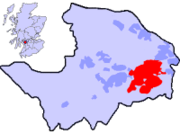
 |
Renfrew |  |
||
| Elderslie | Glasgow | |||
| Barrhead |
The town is surrounded by several large residential areas that were created after the Housing Act of 1946. These include Glenburn (south), Foxbar (south west), Ferguslie Park (north west), Gallowhill (North East) and Hunterhill (South East). Ferguslie Park was named by the Scottish Executive as the most deprived area in Scotland in 2006.[3]
Castlehead, situated to the south-west of the centre of the town, is a wooded area of Victorian villas where many of the town's leading industrialists made their homes in the late 19th century. It is a conservation area.
Oakshaw, situated on a hill to the north of the High Street, is a conservation area and home to many fine buildings including the High Kirk, the Coats Observatory and the former John Neilson Institute, now converted into apartments.
Thornly Park is located to the south of the town. The area is classed as a conservation area with many examples of various architecture ranging from mock Tudor to Art Deco. Many of the houses were designed by W D McLennan, who also designed several local churches such as Saint Matthew's.
Nearer the centre of the town remains many areas of older housing. The town centre, Williamsburgh and Charleston areas contain many examples of Scottish tenement flats. Three to four stories tall, with shops on the ground floor and constructed of local blond and red sandstone, these tenement flats have been extensively restored and modernised over the last two decades.
Gockston in the far north of the town has many terraced houses and, after regeneration has many detached and semi-detached houses as well as several blocks of flats.
Ralston a residential area in the far east of the town bordering Glasgow was outside the Paisley burgh boundary when constructed in the 1930s but, as a result of local authority re-organisation in the 1990s, it is now generally regarded as a suburb of Paisley.
Dykebar, situated to the south east of the centre of the town, is a residential area which is also the site of a secure psychiatric hospital.
Economy

Paisley was at one time famous for its weaving industry. For nearly a hundred years until the 1870s shawls of the Paisley pattern were in fashion. Until the Jacquard loom was introduced in the 1820s, weaving was a cottage industry. This innovation led to the industrialisation of the process. As a result, many weavers lost their livelihoods and left for Canada and Australia.
Paisley was for many years a centre for the manufacture of cotton sewing thread. At the heyday of Paisley thread manufacture in the 1930s, there were 28,000 people employed in the huge Anchor and Ferguslie mills of J & P Coats Ltd (Coats Viyella) said to be the largest of their kind in the world at that time. In the 1950s, the mills diversified into the production of synthetic threads but with cheap foreign imports and the establishment by Coats of mills in India and Brazil the writing was on the wall for Paisley and production began to diminish rapidly. By the end of the 1980s, there was no thread being produced in Paisley. However, both industries have left a permanent mark on the town in the form of the many places with textile related names, for example, Dyer's Wynd, Cotton Street, Thread Street, Shuttle Street, Lawn Street, Silk Street, Mill Street, Gauze Street and Incle Street.
The town also supported a number of engineering works some of which relied on the textile industry, others on shipbuilding.
In the mid 1970s, industry in Paisley went into rapid decline. The preserve manufacturer Robertsons which was founded in Paisley in the 1860s was taken over by Rank Hovis McDougall who closed its Stevenson Street factory and transferred production to Bristol, Manchester and London. This closure was followed by those of the engineering firms of Fullerton, Hodgart and Barclay and Whites Engineering.
In 1981, the area was dealt a massive blow when Peugeot Talbot, formerly Chrysler and before that Rootes, announced that their Linwood factory just outside of Paisley would cease production.[4] Almost 5000 workers were laid off. The knock on effect on other businesses in the area was immeasurable and, despite numerous regeneration projects, Linwood has never recovered.
Brown and Polson commenced producing starch and cornflour in Paisley in the 1860s. It later became CPC Foods Ltd, a subsidiary of Unilever, which produced Hellmann's mayonnaise, Gerber baby foods and Knorr soups. The company ceased production in Paisley in 2002.
Other businesses to have closed since the 1990s are the Scottish Gas distribution and service centre, Cadbury's distribution centre and William Grant & Sons the Scotch whisky producer which moved production to Strathclyde Business Park near Bellshill in Lanarkshire.
Some of the remaining employers in the town are Scotch whisky blenders and bottlers Chivas Brothers now a subsidiary of Pernod Ricard and the pigment manufactory of the Swiss company Ciba Geigy. Both companies employ considerably fewer people than in the past.
Glasgow Airport is a key economic magnet. Loganair's registered office is located by the airport in Paisley.[5]
The public sector is now the main employer in Paisley, with the headquarters of Renfrewshire Council, the University of the West of Scotland, Reid Kerr College, the Royal Alexandra Hospital and a divisional headquarters of Strathclyde Police all located in the town.
Landmarks
In the 1960s the town centre underwent considerable redevelopment resulting in the demolition of the County Buildings in County Square and the adjacent police station and town gaol. These fine Victorian edifices were replaced by the brutalist concrete Gilmour House and the Piazza shopping centre which spans the White Cart Water.
Abbey
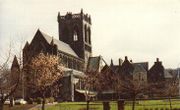
The nave (west) of Paisley Abbey provides an example of original Medieval architecture dating from the 12th century. The earliest surviving architecture is the south-east doorway in the nave from the cloister, which has a round arched doorway typical of Romanesque or Norman architecture which was the prevalent architectural style before the adoption of Gothic. The choir (east end) and tower date from the late 19th and early 20th centuries and are examples of Gothic Revival architecture. They were reconstructed in three main phases of restorations with the tower and choir conforming to the designs of Dr Peter MacGregor Chalmers. The roof in the nave is the most recent of restorations with the plaster ceiling by Dr Rev. Boog which was added in the 1790s being replaced by a timber roof in 1981.
Other notable buildings
Paisley Town Hall (the George A. Clark Town Hall) was funded by Clarks, the owners of the Anchor thread mill. In response, their main competitor in the production of thread in the town, Sir Peter Coats, funded the building of the equally magnificent Paisley Museum and Library in 1871. These, and many other remarkably grand buildings in Paisley, testify to the power, influence and success of the textile industry in the town.
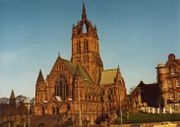
The Coats Memorial Baptist Church or Thomas Coats Memorial Church is an example of Gothic Revival architecture. It dominates the town's skyline with its crown spire more than 60 metres (197 ft) high. Opened in 1894 and designed by Hippolyte Jean Blanc[6] it is the largest Baptist church in Europe. The exterior is made of old red sandstone. Inside, the church is decorated with wood carvings, mosaic floors and marble fonts. The church also contains a 3040 pipe Hill Organ.
The Cathedral Church of Saint Mirin (St Mirin's Cathedral) in Incle Street is the seat of the Catholic Bishop of Paisley. The church was completed in 1931 to replace an earlier building, in nearby East Buchanan Street, which dated from 1808. The original St Mirin's church was the first Catholic church to be built in Scotland since the Reformation. With the erection of the Diocese of Paisley in 1947 the church was raised to cathedral status.
St Matthew's Church (Church of the Nazarene) at the junction of Gordon Street and Johnston Street is Art Nouveau in style. Designed by local architect William Daniel McLennan, a contemporary of Charles Rennie Mackintosh, it was built in 1906.
The Russell Institute was built in 1926.[7]
The "A"[8] listed Anchor Mill (built 1886)[9] was converted, in 2005, into modern apartments. The building is an example of successful redevelopment of old industrial areas.
Paisley Civic Centre designed by Hutcheson, Locke and Monk, a young firm of architects selected as winners of a national (International?) competition and was built in the 1960s to house the Town Council and Renfrewshire County Council Renfrewshire offices. It was intended to become the civic hub for Paisley but the absence of any shops and non-council premises prevented this from happening.[10] It became the home of the Renfrew sub-region of Strathclyde Regional Council in 1975 and of Renfrewshire Council in 1996. It is listed by the conservation organisation DoCoMoMo as one of the sixty key Scottish monuments of the post-war period.
Education
In 1992, Paisley College of Technology, founded in 1896 as Paisley Central Institution, became the University of Paisley which merged with Bell College in Hamilton on 1 August 2007. The merged institution was then renamed as the University of The West of Scotland on 30 November 2007. The town also contains Reid Kerr College, which provides Further Education. There are four Secondary Schools in Paisley: Paisley Grammar School, Castlehead High School, St. Andrew's Academy and Gleniffer High School. The oldest of these is Paisley Grammar which was founded in 1576, and first building erected in 1586.
Until the late 1990s, there were five more secondary schools, now no longer in existence having been the casualties of the reduction in pupil numbers - Merksworth High School (to the north west of the town), John Neilson High School (founded 1852) and St Mirin's High School (on the west side of the town), St Aelred's High School and Stanely Green High School (both on the south side of the town).
Notable people
Well established names in the arts, media and sport from Paisley include
Arts
- Gerard Butler (actor)
- John Byrne (artist and playwright)
- Tom Conti (actor)
- Kari Corbett (actress)
- Jim Dewar (musician and singer/songwriter
- Joe Egan (musician and songwriter)
- Colin Galbraith (writer)
- Anya Gallaccio (artist)
- Matt Healy, Actor (Matthew King from ITV's soap Emmerdale)
- Thomas Kibble Hervey (poet and critic)
- Kenny Ireland (director and actor)
- Jill Jackson (singer/songwriter)
- Patricia Leitch (children's author, Jinny at Finmory series)
- Paul McGillion (actor)
- Kenneth McKellar (tenor)
- Neve McIntosh (actress)
- Steven Moffat (writer)[11]
- Paolo Nutini (singer/songwriter)
- David Tennant (actor)
- Gerry Rafferty (musician and singer/songwriter)
- Kelly Marie (singer; born Jacqueline McKinnon)
- Hector Nicol (Singer/Comedian/Actor)
Media
- Nick Currie (singer/songwriter, journalist)
- Andrew Neil (journalist and television presenter)
- Derek Ogilvie (self proclaimed psychic)
Politics
- Douglas Alexander (politician)
- Wendy Alexander (politician)
- Willie Gallacher (politician)
- Ian Hamilton (lawyer and nationalist)
Sport
- Owen Coyle (footballer and current manager of Bolton Wanderers)
- David Hay (footballer)
- Paul Gallacher (footballer)
- Archie Gemmill (footballer)
- James Grady (footballer)
- Dale Greig (holder of the women's world record for the marathon in 1964)
- Jamie Langfield (footballer)
- Derek McInnes (footballer)
- Paul Lambert (footballer and current manager of Norwich City)
- Robbie Neilson (footballer)
- Lee Peacock (footballer)
- Bernie Slaven (footballer)
- Campbell Money (footballer)
- Mark Ralph (Scottish international hockey player)
Miscellaneous
- James McMillan (author and historian)
Music
In 2010, Paisley was named the UK's eighth 'most musical' region by PRS for Music.[12]
Media
Paisley receives all UK terrestrial television and radio channels, as well as a number of local services. The local daily newspaper is the Paisley Daily Express, which has offices located on New Street in the town centre of Paisley. The locally based radio station Q96 has gone off air and has been replaced with 96.3 Rock Radio. Despite being based in Easterhouse, Glasgow, the terms of the licence state that it must carry Renfrewshire based material.
- Local and regional radio stations
- Clyde 1
- Galaxy Scotland
- Real Radio
- 96.3 Rock Radio, available in Paisley, Renfrewshire and Glasgow
- FPR community radio (Ferguslie Park) (seasonal)
- BBC Radio Scotland
- Regional television Stations
- BBC One Scotland
- STV
Sport
St Mirren F.C., the local Paisley Scottish Premier League football team, were given planning permission to move to a new 8,029 seat stadium from their home on the town's Love Street, to one located on Greenhill Road to help regenerate the deprived Ferguslie Park area. Their last major cup tournament success was on 16 May 1987[13] when St Mirren won the Scottish Cup, with thousands crowding the streets to see the team. Since then, the club has won the Scottish First division title twice, in the 1999-2000 season, and in the 2005-2006 season, as well as winning the Bell's challenge cup in 2005. Mirren is actually the female equivalent of the name Mirin the town's patron saint.
In 2006, the team won the Scottish Football League First Division and has returned to the Scottish Premier League. They have a very active youth development system and are part of the social fabric of the town. This was demonstrated when at a Renfrewshire Council planning committee board meeting on the new stadium and supermarket to replace Love Street came to be heard. With the initial recommendation that St. Mirren be denied permission for the supermarket but allowed the stadium, something that threatened the future of the club due to the supermarket being only solution to clear its debts, some 300 buddies stood outside the final meeting of Renfrewshire Council in Cotton Street on a dry Tuesday Morning in support. The club was granted permission at this meeting with a majority vote of 9-5 in favour. Abercorn F.C. were Paisley's other professional team, but fell into decline and subsequent liquidation in 1920.
On Saturday, January 3, 2009, the last ever match was played at St Mirren's 115-year-old stadium on Love Street. The match, St Mirren vs Motherwell, finished as a rather disappointing 0-0 draw, but the occasion was one of high emotion for the capacity crowd that filled the old stadium for the final time. St Mirren's first match at their new, purpose-built stadium half a mile away on Greenhill Road, was versus Kilmarnock on January 31, 2009, resulting in a 1-1 draw.
Paisley is also home to the Kelburne Hockey Club, who have dominated Scottish domestic hockey in the last 3 seasons. Kelburne HC run 5 gents teams, 3 ladies teams and have over 100 juniors regularly competing for the club at District and National level. Kelburne HC has also supplies the Scottish National Team with the vast majority of the Gents' team. The club has also had success in Europe with recent tournament victories in Austria and Switzerland.
Motorcycle speedway was staged at St Mirren Park in 1975 and 1976 when the Paisley Lions raced in the second division of the British League. The Lions were moderately successful but despite the best efforts of their supporters, the venue was lost to speedway.
Transport
Glasgow International Airport's terminal buildings are located to the North of Paisley at Abbotsinch. The airport authority and the many businesses located in around the airport are a major source of employment for Paisley and towns nearby.
Paisley is connected to the UK motorway network with the M8 running along the northern edge of the town. This forms part of the unsigned E05 Euroroute from Greenock to Gibraltar. Many major A roads converge through the town including the A726, A737 and A761.
Over the years there have been thirteen railway stations in Paisley and three rail lines that are now closed. The Paisley and Barrhead District Railway,[14] the Barrhead Branch[14] of the GSWR, and the Paisley and Renfrew Railway.[15]
The town is linked by rail to Glasgow city centre as well as Inverclyde and the Ayrshire coast, being served by four stations (Paisley Gilmour Street, Paisley St James, Paisley Canal and Hawkhead). The rail links also connect to Glasgow Prestwick International Airport and ferry routes to Dunoon, the Isle of Arran, Isle of Bute and Ireland.
Built in 1807, the Glasgow & Ardrossan canal ran from Port Eglinton in Glasgow to Paisley. Despite initial plans, the canal never reached Ardrossan terminating at Thorn Brae in Johnstone. (See Glasgow, Paisley and Johnstone Canal). After closure in 1885, the canal was drained and formed the basis for the Glasgow and South Western Railway Company's Paisley Canal Line connecting Glasgow to Paisley, and onward to Elderslie, Bridge of Weir and Greenock. The second Paisley Canal railway station is operational.
Dooslan Stane
The Dooslan Stane was originally found at the corner of Neilston Road and Rowan Street in Paisley but now lies in Brodie Park. The stone was once carved with the details of its history but this has now largely been eroded.
The stone was the meeting place of the Weavers Union in the South of Paisley and was also used as a "soapbox". It was later moved to its present location in Brodie Park. Also present, arranged around the Dooslan Stane, are the four original Paisley Tolbooth stones. The Dooslan Stane is still used today as the congregating point for the annual Sma' Shot parade which takes place on the first Saturday in July.[16]
See also
- Castlehead, Paisley
- University of the West of Scotland
- Paisley canal disaster
- Inkerman, Paisley
- Paisley (design)
- Paisley Grammar School
- Castlehead High School
- St Mirin's Academy
- Gockston
References
- ↑ "Extracts from the records - 1588". http://www.british-history.ac.uk/report.asp?compid=47680.
- ↑ http://www.victoriana.com/library/paisley/shawl.html victoriana.com
- ↑ BBC News, "Scotland reveals most deprived areas", October 2006
- ↑ Allan, Robert J (1991).Geoffrey Rootes' dream for Linwood. Minster Lovall: Bookmargue Publishing. ISBN 1-870519-12-4
- ↑ "Statutory Information." Loganair. Retrieved on 20 May 2009.
- ↑ "Thomas Coats Memorial Church: Architecture". http://www.fenet.co.uk/coats/arch.htm.
- ↑ "History of Paisley - Paisley.org.uk". http://www.paisley.org.uk/history/russell.php.
- ↑ "ArchitectureScotland.co.uk". http://www.architecturescotland.co.uk/practices/portfolio/33/Refurbishment_%26_Conversion_of_the_Domestic_Finishing_Mill%2C_Anchor_Mills%2C_Paisley.
- ↑ "The Prince's Regeneration Trust". http://www.princes-regeneration.org/index.php?n=PT.AnchorMills.
- ↑ Frank Arneil Walker (1986). The South Clyde Estuary. RIAS Publishing. ISBN 0-7073-0476-8.
- ↑ Staff writer (5 January 1989). "Write first time". The Stage: p. 15.
- ↑ Smith, Richard (13 March 2010). "Bristol named Britain's most musical city". http://www.mirror.co.uk/celebs/news/2010/03/13/bristol-named-britain-s-most-musical-city-115875-22107650/. Retrieved 2010-05-11.
- ↑ "Scottish Football Association: The Scottish FA: Scotland :". http://www.scottishfa.co.uk/scottish_football.cfm?curpageid=551.
- ↑ 14.0 14.1 http://homepage.ntlworld.com/sealed/paisley/railpage/pbdr.htm homepage.ntlworld.com
- ↑ http://homepage.ntlworld.com/sealed/paisley/railpage/renfrew.htm homepage.ntlworld.com
- ↑ "Paisley Online". http://www.paisleyonline.co.uk/html/parks.html.
External links
|
|||||||||||||||||||||||